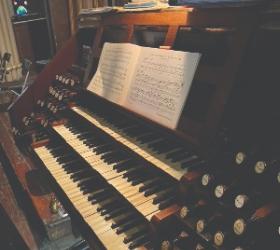
Juget-Sinclair Organbuilders,
Montréal, Québec, Canada
Hatsudai Catholic Church,
Tokyo, Japan
Installed in the loft at the back of the nave, the instrument is of 17 stops on two 58-note manual divisions (Grand Orgue and Récit expressif) and a 30-note Pédale division. Only the Grand Orgue is visible from the nave; the Récit expressif is behind the Grand Orgue and the Pédale is situated beneath the Récit on floor level. Some details of its composition and construction, with its oak casework and round towers, suggest a post-classical French inspiration, but our principal guide is really our own mechanical aesthetic. Pipe scales and construction methods are not based on specific historical examples, but are our own; they are a synthesis of our experience as organbuilders and an expression of ourselves.
Some aspects of the instrument, however, are more often associated with the romantic organ. In the treble range, stops were voiced with increasing power and—in the case of the Grand Orgue principals—wider scale. The disposition of both manual divisions on one level favors the blending of the 8' voices. In the Récit expressif, the Salicional 8' and the Principal 4' have tuning slots, which give a penetrating timbre and enough power to project from within the swell box. The Bourdon 8' has a second slider, called Bourdon Céleste, which de-tunes the pipes to create a celeste effect when drawn with the Salicional. The Cornet has been broken down into its component ranks for the sake of flexibility. Separately, the mutations offer a myriad of colors. Used together, they give the Cornet a meaty quality, rendered more acidic when the Principal 4' replaces the Flûte 4'. The Hautbois 8' is lyrical and blends well with the 8' flue stops. The limited size of the Pédale division places increased importance on the success of each stop. The Principal 8' speaks quickly throughout, punctuating the bass line. Due to the favorable acoustics of the church, the basses did not have to be forced, speaking naturally and gently enough for more subtle registrations and gaining power as more stops are drawn.
—Denis Juget, Stephen Sinclair
Grand Orgue
8' Montre
8' Flûte à cheminée
4' Prestant
4' Flûte
2' Doublette
Fourniture III
8' Trompette
Récit expressif
8' Salicional
8' Bourdon
8' Bourdon Céleste (from Bourdon 8')
4' Principal
4' Flûte 4
22'3' Nazard
2' Flûte
13'5' Tierce
8' Hautbois
Tremblant doux
Pédale
16' Soubasse
8' Principal
Couplers II/I, I/P, II/P
58-note keyboards with boxwood naturals and ebony sharps
30-note flat pedalboard with rosewood sharps
All pipe bodies are thinned at the tops
Suspended key action, self-adjusting on manuals and pedal with pneumatic tensioners
Mechanical stop-action
White oak casework, with mortise and tenon construction, hand-planed and oiled
Hand-carved pipe shades
One cuneiform bellows




